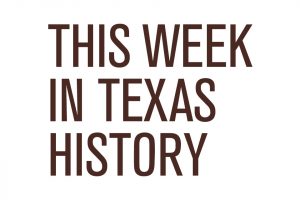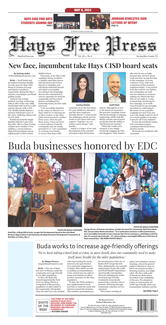By Bartee Haile
A young marine from South Texas was one of six American fighting men caught on camera on Feb. 23, 1945 raising the Stars and Stripes on a Pacific battlefield called Iwo Jima.
Harlon Henry Block was born in 1924 at Yorktown and grew up on 40 acres in the Rio Grande Valley. The third of six children, he had one sister and four brothers.
Harlon’s mother missed the city life of San Antonio and never quite adjusted to the hardscrabble existence down on the farm. Finding comfort and encouragement in the Seventh Day Adventist Church, Belle Block put in long days nursing the terminally ill in order to send her children to the local Adventist school.
Harlon may have been the most religious of the Block kids, but that did not mean he was a pushover. More than once he stood up to the principal, and the last time, when he refused to snitch on a vandal, got him kicked out of school.
The expulsion was a blessing in disguise for the natural athlete, who enrolled in high school at nearby Weslaco. Over the objections of his mother but to his father’s delight, Harlon tried out for football. He not only made the team but became a star player excelling at punting, blocking and catching passes.
As a senior in 1942, Harlon figured prominently in the Panthers’ undefeated season. He was named to the All South Texas eleven and considered for a gridiron scholarship.
But combat, not college, was in Harlon’s plans. The day he announced that he was enlisting in the Marine Corps with 12 teammates, Belle reminded him Seventh Day Adventists were conscientious objectors who served their country as medical personnel.
Harlon ruled out the pacifist option and insisted upon fighting alongside his buddies. His mother refused to give her consent, but his father, a World War I veteran, signed the necessary papers in the belief, according to a brother, “it will make him a man.”
Basic training at San Diego was followed by paratrooper school. Harlon was assigned to the First Marine Parachute Regiment and shipped out in November 1943 a week after his 19th birthday.
Harlon’s naive notions of battle were shattered on Bougainville, the next stop after Guadacanal in the Pacific island-hopping campaign. A fellow marine called the godforsaken place “the closest thing to a living hell that I ever saw in my life.”
Harlon came home on furlough in March 1944 a traumatized shell haunted by a sense of impending doom. He shared his fatalistic vision with everyone who would listen, everyone, that is, except his parents.
“I don’t think I’ll be coming back,” Harlon confided to the wife of a former teammate. Big brother Ed Jr. laughed off the gloomy prediction but knew deep down he was as serious as a heart attack. “He wasn’t joking around.”
The first waves of 70,000 marines went ashore at Iwo Jima on Feb. 19, 1945. Dug into the 11 square miles of volcanic rock were 22,000 of Imperial Japan’s most fanatical troops prepared to fight to the last man rather than surrender.
Four days and thousands of lives later, a group of marines reached the top of Mount Suribachi, the highest point on the island, and hoisted the first foreign flag ever flown over Japanese territory. Orders were soon issued to replace the small banner with an eight-by-five-and-a-half-foot Old Glory salvaged from a sunken ship at Pearl Harbor.
Three photographers were present for the second flag-raising. The larger Stars and Stripes was secured to a ten-foot, 100-pound pipe, which Harlon planted on the summit as five comrades pushed the heavy staff into place. Joe Rosenthal of the Associated Press snapped several quick shots in the hope that one at least would turn out okay.
The picture that won the wire-service cameraman a Pulitzer Prize appeared on the front page of nearly every newspaper in the country on Sun., Feb. 25. Ed Jr. was sitting in the living room reading the Weslaco Mid-Valley News, when his mother pointed at the photo and exclaimed, “Look there, Junior! There’s your brother Harlon.”
“Momma, there’s no way you can know that’s Harlon. That’s just the back of a marine. And besides, we don’t even know Harlon is on Iwo Jima.”
“Oh, that’s definitely Harlon,” Belle Block replied. “I know my boy.”
Corporal Harlon Block never saw the most famous photograph of World War II. Killed in action on Mar. 1, he was among the more than 6,000 Americans that did not make it off Iwo Jima alive.
The figure on the far right of the Rosenthal picture was originally misidentified as a dead marine from Boston. It took one of the surviving flag raisers to set the record straight.
Ira Hayes, the troubled Pima Indian who eventually drank himself to death, hitchhiked 1,300 miles from an Arizona reservation to South Texas in May 1946. He found Harlon’s father hard at work in a cotton field and told him the truth.
In a letter to a grateful Belle Block, Hayes later wrote, “It did not seem right for such a brave marine as your son not to get any recognition.”
Still don’t have a copy of Bartee’s latest book “Texas Boomtowns: A History of Blood and Oil”? Order yours today with a check for $28.80 to Bartee Haile, P.O. Box 152, Friendswood, TX 77549 or on-line at barteehaile.com.






